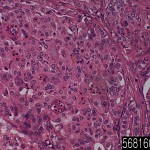| Product name | Liver cholangiocarcinoma |
| Cat. No. | 5681603A |
| No. of samples | 1 |
| Description | liver, cholangiocarcinoma Age/Sex : 63/M |
| Price | 197 EUR |
| 260 USD | |
| 170 GBP |
Product Related Literature
Bile duct is a medical term that means including, (characteristic or cells, of epithelial differentiation) mutant epithelial cells to discharge bile duct-derived bile from the liver to the intestine, a form of cancer. I include the ampoule of Vater other biliary tract cancer, pancreatic cancer, and gallbladder cancer,. Bile duct cancer can be classified into (cancer that emits a large amount of mucin, or to form a gland) adenocarcinoma, but are relatively rare tumors. It has 1-2 cases annual incidence of 100 per 000 in the Western world, the incidence of bile duct cancer is increasing all over the world over the past few decades.
The signs and symptoms of some of the bile duct cancer include abnormal liver function tests, abdominal pain, jaundice, weight loss. It may itch, fever, change in color of urine or stool may occur. Combination of blood tests were confirmed obtained after pathologist examined the tumor cells under a microscope, imaging, endoscopy, and the disease is diagnosed by surgical studies in some cases. The known risk factors of bile duct cancer, primary sclerosing cholangitis liver infection (inflammatory disease of the bile duct), congenital malformations, and liver flukes or parasitic liver fluke Opisthorchis viverrini, and exposure to Thorotrast (thorium dioxide The), medical image chemicals used previously included. However, I do not have the risk factor of identifiable specific most of the bile duct cancer patients.
With the exception of the primary tumor, and is considered to be a lethal malignant tumor rapidly and incurable, bile duct cancer, can be resection (surgical removal) completely transition of any. Except for the operation, therapeutic potential, does not exist yet, it has an advanced stage of disease at presentation, most patients can not be used for diagnosis. Be cured but is not – – and other measures for chemotherapy, radiation therapy, palliative care usually is dominated by patients with bile duct cancer. They also, (ie, after surgery) is used as an adjuvant (or near) resection is apparently successful. (E.g., erlotinib, etc.) The current involves the use of photodynamic therapy or new targeted therapies for technical treatment and for measuring the concentration of by-products of cancer formation of stromal cells in the blood for diagnostic purposes some areas of medical research bile duct cancer
Examination of the liver, (skin bile duct or yellowing of the eye is blocked by tumor, occurred) jaundice, itching physical symptoms of the most common bile duct cancer, abdominal pain (30% to 50%), (66% (30% to 50% weight loss is changed to)), the change in the color of urine or feces and fever (20%). To some extent, the symptoms depend on the location of the tumor: likely to have jaundice extrahepatic bile duct cancer patients is high, but in many cases, those with a tumor in the liver bile duct without pain, jaundice.
In many cases, blood tests of liver function in bile duct cancer patients, indicating so-called “picture obstruction” with relatively normal levels of transaminase levels and gamma guru Tamil transferase bilirubin, and alkaline phosphatase. The findings of these, because it is the main cause of jaundice, biliary obstruction, and suggesting inflammation and infection without the liver parenchyma. CA19-9 is increased in most cases of bile duct cancer.
It is the majority of patients presenting risk factors not known clearly, but the number of risk factors for the development of bile duct cancer is disclosed. In the Western world, the most common of these is an inflammatory disease primary sclerosing cholangitis itself associated with (UC) closely ulcerative colitis (PSC), the bile duct. Autopsy series have found that the high rate of 30% in this population, but the lifetime risk of developing cholangiocarcinoma surface PSC, epidemiological studies have demonstrated that a -15% to about 10%. The PSC, a mechanism to increase the risk of bile duct cancer are not well understood.
The parasitic disease of some sort of liver, there is a risk factor as well. Colonization with (Japan, Korea, and Vietnam) or liver fluke (or Thailand, Laos, Malaysia) liver fluke Opisthorchis viverrini is associated with the development of bile duct cancer. Chronic liver disease, viral hepatitis (for example, C or hepatitis B type) whether in the form of a. Other reasons, and are exposed to fairly increase risk of bile duct cancer in cirrhosis and alcoholic liver disease of the liver. (For example, HCV infection) is not known whether there is a responsibility in association interference factor and cutting other or HIV itself, but also HIV infection, it is determined by the test as a risk factor potential of bile duct cancer.
The inborn errors of liver, the risk of developing life bile duct cancer is associated with about 15% as the common bile duct cyst and Caro’s syndrome like this. Be associated presence of gallstones cholangiocarcinoma.The not associated with bile duct cancer clearly in biliary tract papilloma and hereditary Lynch syndrome II and rare (cholelithiasis) was found. However, (referred to as intrahepatic) intrahepatic stones are rare, in general, are associated with bile duct cancer strongly in some areas of Asia in the West. With the development of bile duct cancer, Toro trust, form of thorium dioxide that is used Toro trust, as a contrast agent, exposure to radiation, the United States in 1950 because of its carcinogenic 30 to ’40 after exposure out was banned.

